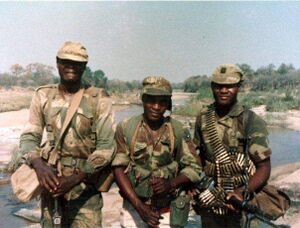Embambas: Difference between revisions
No edit summary |
No edit summary |
||
| Line 3: | Line 3: | ||
|unit_name=Embambas | |unit_name=Embambas | ||
|image= [[File:EmbambasEE.jpg|300px]] | |image= [[File:EmbambasEE.jpg|300px]] | ||
|caption= | |caption= A trio of Embambas pose near an oasis. | ||
|country=[[Kwalawi]], [[Red River Free State]], [[Jafala]] | |country=[[Kwalawi]], [[Red River Free State]], [[Jafala]] | ||
|allegiance={{flag|Empire of Exponent}} | |allegiance={{flag|Empire of Exponent}} | ||
Latest revision as of 01:23, 4 February 2024
| Embambas | |
|---|---|
 A trio of Embambas pose near an oasis. | |
| Active | 1963-1996 |
| Country | Kwalawi, Red River Free State, Jafala |
| Allegiance | |
| Branch | Security forces |
| Type | Special Forces |
| Role | Special Reconnaissance, Raids, Counter-Terrorism, Tracking, and Bushcraft |
| Engagements | Hesperidesian Revolutions |
| Commanders | |
| Notable commanders | Simi Kalibazi |
The Embambas (Jafalan for Spears) were a special forces unit of the Imperial Exponential secret police that operated in several theaters during the Hesperidesian Revolutions. Unlike most of the other Imperial special forces that were employed in the several areas of operations of the conflict, the Embambas were not a military unit but a police unit.
Embambas were organized as platoon-sized units consisting of local tribesmen and rebel defectors who specialised in tracking, reconnaissance and pseudo-terrorist operations. They sometimes patrolled in captured uniforms and were rewarded with cash bounties for every guerrilla or guerrilla weapon they captured.
History
Embamba units were created and employed in Jafala under the command of the Imperial Secret Police in 1965. Composed of locally recruited men, often former guerrilla fighters but mostly bushman, the units specialised in tracking, reconnaissance and pseudo-terrorist operations. The Emabambas were employed with great success in the Livaria-Estumi campaign in Eastern Kwalawi in the early 1970s. Many members of the Imperial General Staff argued that native soldiers were cheaper, knew the terrain better, and were better able to create a relationship with the local populace, a tactic that predates the 'hearts and minds' strategy later used by numerous other nations in conflicts to come. Embamba units were to continue to cause problems for the new states even after independence and Imperial withdrawal, when the countries began to turn against each other in the War of the Brothers and Embambas personnel were deployed to harass positions of all sides of the conflict.
Organization and Equipment
The Emabambas first saw action in the remote areas that the Imperial soldiers deemed no-go zones - especially in far eastern Jafala. The Emabambas were organized in groups of about 30 men, although the formation was often loose. They were equipped with some of the equipment in use in the Imperial Exponential Army, but most troops used weapons captured from the guerrillas and some used traditional weapons like bows and spears.
Their best known uniform item was the camouflage beret with the spear insignia on it, which became one of its most notable symbols.
